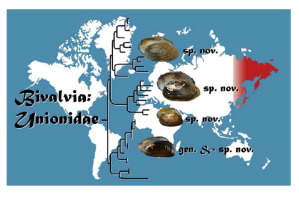当前位置:
X-MOL 学术
›
Mol. Phylogenet. Evol.
›
论文详情
Our official English website, www.x-mol.net, welcomes your
feedback! (Note: you will need to create a separate account there.)
Freshwater mussels (Bivalvia: Unionidae) from the rising sun (Far East Asia): phylogeny, systematics, and distribution.
Molecular Phylogenetics and Evolution ( IF 3.6 ) Pub Date : 2020-02-03 , DOI: 10.1016/j.ympev.2020.106755 Manuel Lopes-Lima 1 , Akimasa Hattori 2 , Takaki Kondo 3 , Jin Hee Lee 4 , Sang Ki Kim 5 , Akihisa Shirai 6 , Hironori Hayashi 7 , Taira Usui 8 , Kanta Sakuma 9 , Taishi Toriya 10 , Youhei Sunamura 11 , Haruki Ishikawa 11 , Naoki Hoshino 12 , Yushi Kusano 13 , Hinata Kumaki 2 , Yuya Utsugi 2 , Shinnosuke Yabe 2 , Yuma Yoshinari 2 , Hazuki Hiruma 2 , Akiko Tanaka 2 , Kentaro Sao 2 , Takuya Ueda 14 , Isao Sano 15 , Jun-Ichi Miyazaki 16 , Duarte V Gonçalves 17 , Olga K Klishko 18 , Ekaterina S Konopleva 19 , Ilya V Vikhrev 20 , Alexander V Kondakov 20 , Mikhail Yu Gofarov 19 , Ivan N Bolotov 19 , Elena M Sayenko 21 , Marianna Soroka 22 , Alexandra Zieritz 23 , Arthur E Bogan 24 , Elsa Froufe 25
Molecular Phylogenetics and Evolution ( IF 3.6 ) Pub Date : 2020-02-03 , DOI: 10.1016/j.ympev.2020.106755 Manuel Lopes-Lima 1 , Akimasa Hattori 2 , Takaki Kondo 3 , Jin Hee Lee 4 , Sang Ki Kim 5 , Akihisa Shirai 6 , Hironori Hayashi 7 , Taira Usui 8 , Kanta Sakuma 9 , Taishi Toriya 10 , Youhei Sunamura 11 , Haruki Ishikawa 11 , Naoki Hoshino 12 , Yushi Kusano 13 , Hinata Kumaki 2 , Yuya Utsugi 2 , Shinnosuke Yabe 2 , Yuma Yoshinari 2 , Hazuki Hiruma 2 , Akiko Tanaka 2 , Kentaro Sao 2 , Takuya Ueda 14 , Isao Sano 15 , Jun-Ichi Miyazaki 16 , Duarte V Gonçalves 17 , Olga K Klishko 18 , Ekaterina S Konopleva 19 , Ilya V Vikhrev 20 , Alexander V Kondakov 20 , Mikhail Yu Gofarov 19 , Ivan N Bolotov 19 , Elena M Sayenko 21 , Marianna Soroka 22 , Alexandra Zieritz 23 , Arthur E Bogan 24 , Elsa Froufe 25
Affiliation

|
Freshwater mussels (Bivalvia: Unionidae) is a diverse family with around 700 species being widespread in the Northern Hemisphere and Africa. These animals fulfill key ecological functions and provide important services to humans. Unfortunately, populations have declined dramatically over the last century, rendering Unionidae one of the world's most imperiled taxonomic groups. In Far East Asia (comprising Japan, Korea, and Eastern Russia), conservation actions have been hindered by a lack of basic information on the number, identity, distribution and phylogenetic relationships of species. Available knowledge is restricted to studies on national and sub-national levels. The present study aims to resolve the diversity, biogeography and evolutionary relationships of the Far East Asian Unionidae in a globally comprehensive phylogenetic and systematic context. We reassessed the systematics of all Unionidae species in the region, including newly collected specimens from across Japan, South Korea, and Russia, based on molecular (including molecular species delineation and a COI + 28S phylogeny) and comparative morphological analyses. Biogeographical patterns were then assessed based on available species distribution data from the authors and previous reference works. We revealed that Unionidae species richness in Far East Asia is 30% higher than previously assumed, counting 43 species (41 native + 2 alien) within two Unionidae subfamilies, the Unioninae (32 + 1) and Gonideinae (9 + 1). Four of these species are new to science, i.e. Beringiana gosannensissp. nov., Beringiana fukuharaisp. nov., Buldowskia kamiyaisp. nov., and Koreosolenaia sitgyensisgen. & sp. nov. We also propose a replacement name for Nodularia sinulata, i.e. Nodularia breviconchanom. nov. and describe a new tribe (Middendorffinaiini tribe nov.) within the Unioninae subfamily. Biogeographical patterns indicate that this fauna is related to that from China south to Vietnam until the Mekong River basin. The Japanese islands of Honshu, Shikoku, Kyushu, Hokkaido, and the Korean Peninsula were identified as areas of particularly high conservation value, owing to high rates of endemism, diversity and habitat loss. The genetically unique species within the genera Amuranodonta, Obovalis, Koreosolenaiagen. nov., and Middendorffinaia are of high conservation concern.
更新日期:2020-02-03











































 京公网安备 11010802027423号
京公网安备 11010802027423号